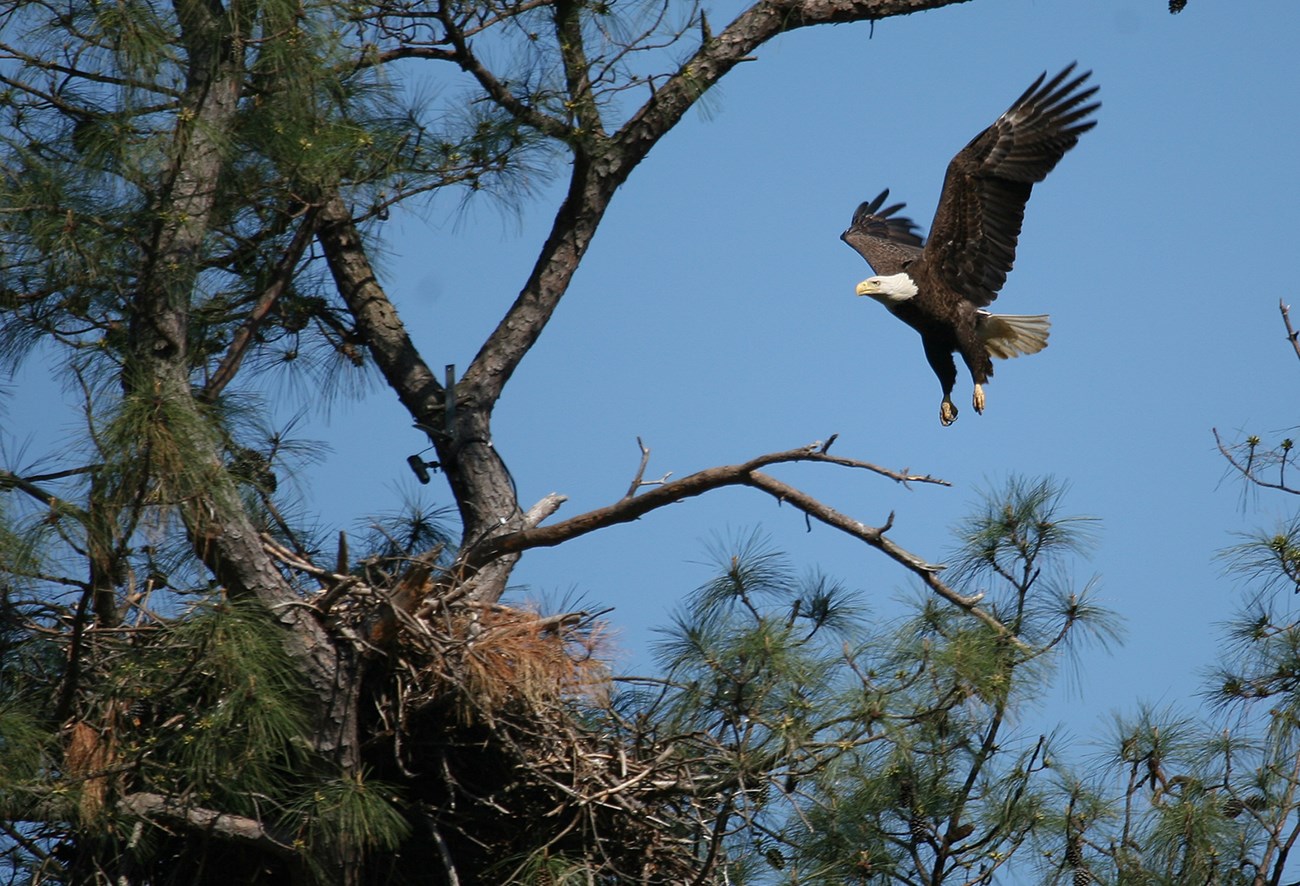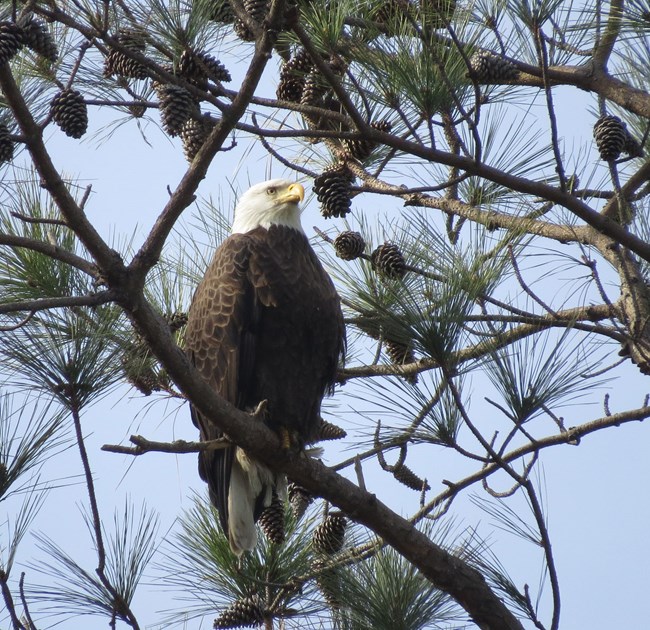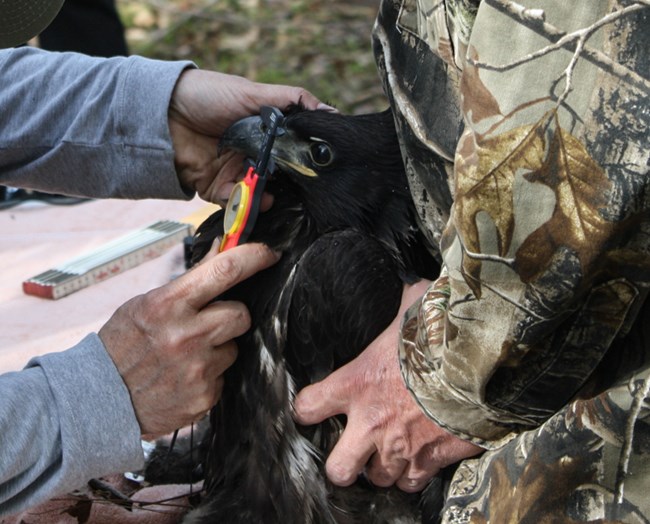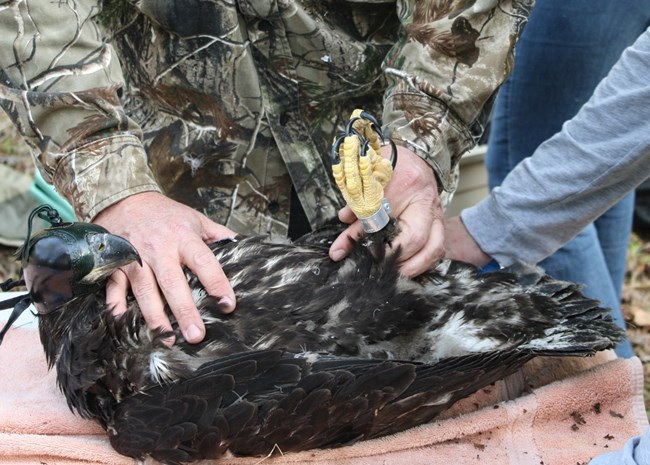Part of a series of articles titled Northeast Coastal and Barrier Network Species Spotlight.
Article
Northeast Coastal and Barrier Network Species Spotlight: Bald Eagle

Dan Earnhart
Background
The bald eagle (Haliaeetus leucocephalus) is the national symbol of the United States of America. Recognized by its distinctive head of white feathers, the bald eagle can weigh up to 14 pounds and reach a massive wingspan of 6-8 feet when full grown. Sexually dimorphic, female bald eagles outweigh males. They are found across the entire continental United States along with bountiful populations in Alaska. Bald eagles are fully brown as juveniles and do not acquire the distinctive white head feathers until they are adults. Misidentification is common between bald eagles and other birds of prey such as the golden eagle and osprey. Being a predatory bird, bald eagles prefer woodlands along the coast and near large bodies of water such as lakes where plentiful amounts of fish are available to hunt. When not hunting themselves, they have garnered a reputation as one of the animal kingdom’s most notorious scavengers. Bald eagles will commonly pick from carrion or steal meals directly from smaller birds of prey. This reputation as a scavenger has drawn criticism from some, including one of America’s founding fathers, Benjamin Franklin, conveyed in a letter to his daughter Sarah:
“I wish the bald eagle had not been chosen the representative of our country. He is a bird of bad moral character. He does not get his living honestly.” ~Benjamin Franklin, January 1784
Bald eagles are tertiary consumers, consuming a wide variety of organism, which makes them susceptible to environmental pollutants. In the Chesapeake Bay, potential prey of bald eagles come in contact with environmental contaminants such as polychlorinated biphenyls (PCBs), pesticides from runoff, and metals such as mercury (Hg) which causes contamination and the potential for biomagnification.

Dan Earnhart
Recovering from the brink
The rise of dichloro-diphenyl-trichloroethane (DDT) as an agrochemical in the post-war era had detrimental effects on bald eagle populations across North America. DDT was first thought to be an extremely safe and effective pesticide when it was first discovered in 1939. It was not until years later through the public activism and campaign to ban DDT by conservationist and author Rachel Carson that scientists uncovered DDT in its broken down form, dihloro-diphenyl-dichloroethylene (DDE), was being exposed in large quantities to fish and small mammals which are the main food source of the bald eagle. Through biomagnification, many birds of prey ingested the chemical which caused reproductive health problems and the formation of thin eggshells, causing hatchling numbers to decrease rapidly. By 1963, just under 490 nesting pairs were all that was left in most of the lower 48 states. The bald eagle was designated as an endangered species in the late 1960s, but since the banning of DDT in 1972 and raised awareness and conservation efforts, bald eagles have recovered from the brink of extinction. Since 2007, the species has been delisted as an endangered species.
On the banks of the Chesapeake Bay, bald eagle populations have bounced back, and the landscape is reminiscent of times before bald eagles were affected by DDT. Situated on the Chesapeake Bay, Colonial National Historical Park (COLO) is home to a number of nesting pairs.

Dan Earnhart
Research efforts at Colonial
At COLO, biologists from various organizations have done extensive work pertaining to the research and rehabilitation of the Chesapeake Bay’s population of bald eagles. Currently, the Greater Chesapeake Bay area has the largest concentration of bald eagles, including nesting pairs, of anywhere outside of Alaska in North America. The Center for Conservation Biology (CCB) has monitored bald eagle activity within COLO. CCB utilizes flyovers to detect new and existing nest, eggs, and fledglings. With the help of citizen scientists from the Historic Rivers Master Naturalists’ Wildlife Mapping team, monthly observations are taken on Jamestown Island, Virginia. Particularly during nesting season, the Wildlife Mapping team monitors eagles. Bald eagles are congregating enough for the island to be designated as an eagle roost.

Dan Earnhart
Regardless of their great success story in the post-DDT era United States, it is still important for the CCB to conduct research and monitoring efforts to understand bald eagle populations and their nesting behaviors. This information can then be relayed to park officials at COLO. The rise in population since the 1970s has coincided with increased human development along the Chesapeake as well. While these birds are able to adapt and survive near human development, nesting pairs still need suitable forested areas along the water to nest.
With human development (and possible contamination) nearby, the National Park Service (NPS) biologists partnered with the CCB and the United States Fish & Wildlife Service (USFWS) and conducted a study on the susceptibility of bald eagle nestlings to contaminants on NPS land. Biologists tested for the presence of heavy metals, organochlorine pesticides (OCPs) and polychlorinated biphenyls (PCBs). Low levels of all contaminants were found in nestlings analyzed. All levels of OCPs and PCBs tested for were below levels which would cause reproductive impairment. Heavy metals tested for were also in low levels, while Hg concentrations were categorized as low-middle ranged in value. One takeaway was that nestlings residing along high saline waters had lower concentrations of Hg.
To continue monitoring the success of bald eagles at COLO, the park will pursue monitoring of the nesting success on Jamestown Island in the future. The data and guidance from CCB will provide the park with information to manage the ecosystem on Jamestown Island over the coming years as sea level rise threats increase.
Check out the Eagle Nest Locator courtesy of the Center for Conservation Biology to locate bald eagle nests at Colonial National Historical Park!
Written by Edward Cascella, Geoscientists-in-the-Parks (GIP) Intern
Last updated: November 27, 2019
